The Apple iPhone 6s and iPhone 6s Plus Review
by Ryan Smith & Joshua Ho on November 2, 2015 8:00 AM EST- Posted in
- Smartphones
- Apple
- Mobile
- SoCs
- iPhone 6s
- iPhone 6s Plus
Battery Life
With any smartphone, battery life is always one of the most important considerations. It probably goes without saying that more battery life is always better. In the case of the iPhone 6s, battery life is especially important to examine because this year Apple has actually made the battery of their phone smaller than before. Normally, it’s almost a given that battery size will be at least constant or increase but in order to accommodate additional components like the Taptic engine the battery has been made smaller. In light of this reversal one might assume that battery life has decreased as a result, but given the move to a FinFET process and other major component improvements it’s hard to say how battery life has increased or decreased. In order to test this properly, we ran the iPhone 6s’ through our suite of battery life tests to try and get an idea for overall battery life. As always, we run all battery life tests with the display set to an average of 200 nits and all possible background tasks disabled.
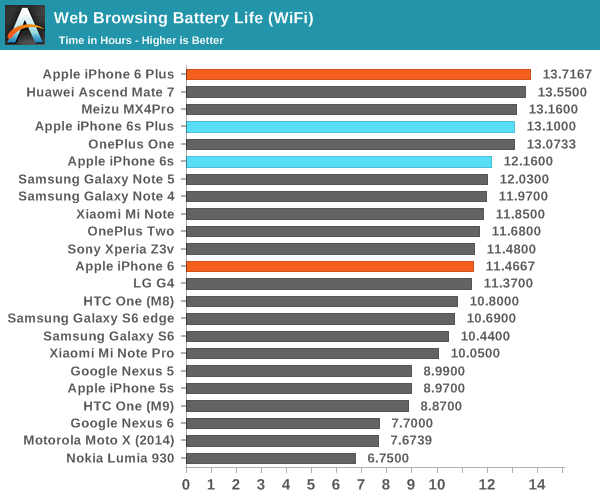
Our first test is WiFi web browsing, and here we see a pretty curious trend. The iPhone 6s Plus appears to regress relative to the iPhone 6 Plus, yet the iPhone 6s solidly beats the iPhone 6. I was pretty confused by this, but it’s likely that we’re seeing these results because the iPhone 6s is going to have larger relative power consumption of the SoC when compared to the display. As the display becomes bigger, the effects of SoC efficiency are just harder to notice, which also explains why it looks like the iPad Air 2 has effectively the same battery life whether you’re running just a blank display or our web browsing test. Both of our review units use a TSMC A9, so I don’t think we can attribute a foundry difference to the odd results that we’re seeing here.
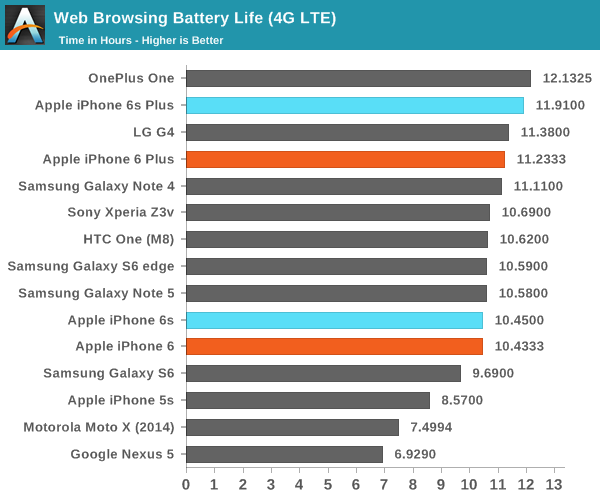
In LTE web browsing, we see a smaller improvement than what we observed in the WiFi test. This might seem strange, but given that the move from a 28nm process to a 20nm process on the modem from iPhone 6 to 6s didn’t come with FinFET it makes sense that the modem will remain a significant power drain. It’s likely that the next big jump in battery life here will come with FinFET process technology on the modem, along with other general modem design improvements.
In order to also look at battery life in more extreme scenarios, we use Basemark OS II and GFXBench to really place a strong stress on the CPU and GPU to see what power draw is like under sustained load. This also allows us to see the extent to which various components of the phone throttle down in response to relatively high sustained loads. However, it’s important to note that the Basemark OS II performance score here isn’t necessarily as accurate as scores from Android devices as the battery score can be calculated with 98 data points instead of 80 as battery score is partially derived from the rate at which the battery percentage decreases. It's also worth noting that in GFXBench there are two data points removed as the low power popup causes an incorrect frame rate to be recorded.
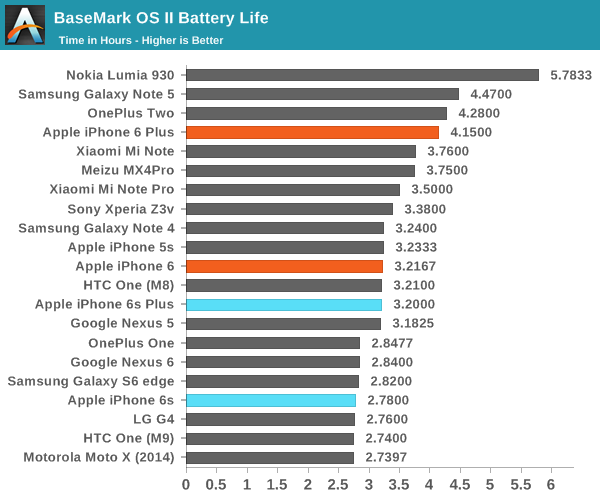
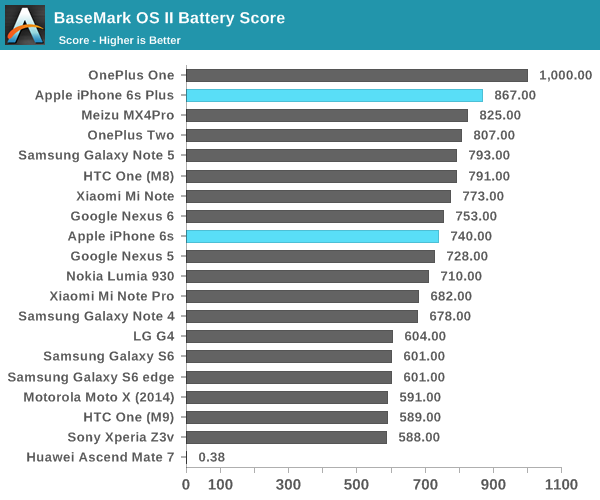
In Basemark OS II, we start off with a pretty shocking result as the iPhone 6s lasts less than three hours in this test, but looking at the battery score it’s pretty clear that the reason why the iPhone 6s doesn't last very long is because it’s running with relatively little throttling throughout the test, so the battery score is high as a result. The same is true of the iPhone 6s Plus, but the larger battery helps it to last a bit longer.
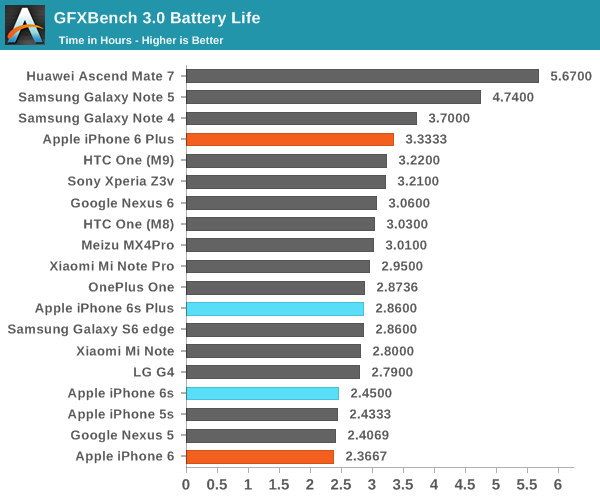
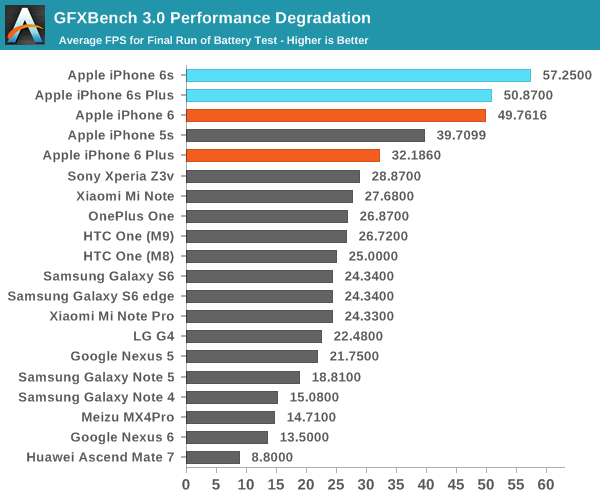
Looking at GFXBench, which is an infinite loop of the T-Rex on-screen benchmark to approximate intensive video gaming we see that the iPhone 6s doesn’t last very long either, but the performance throughout the test is incredible. Due to 1334x750 display resolution and strong GPU, the iPhone 6s manages to last the entire test without any notable throttling, and effectively pegged at the refresh rate of the display. The iPhone 6s Plus manages a similar level of performance but over time you can start to see some throttling, likely a function of the longer runtime and higher display resolution. It’s interesting to see how in the space of two years just how much progress has been made here in terms of improving GPU performance and efficiency, as when we first ran this test it was probably one of the most stressful tests out there for any smartphone or tablet.
Charge Time
Of course, while battery life is usually the main determinant of overall mobility it’s often important to consider charge time. A phone that charges slowly can be much less mobile than another phone, even if it has better battery life. In the case of the iPhone 6s’, it seems that Apple continues to ship the standard 5W charger that they have for many generations in the smartphone industry. In order to see how this charger and phone combination performs, we use our usual methods of timing the phone from fully discharged to fully charged.
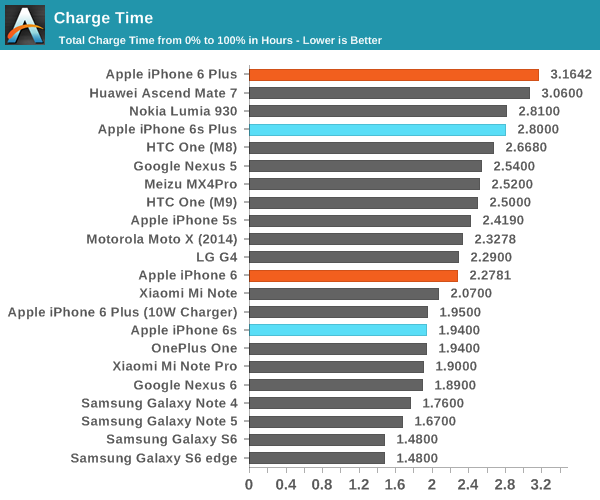
Here, the iPhone 6s and 6s Plus both show a decent improvement over the iPhone 6 and 6 Plus, but not enough to make an significant difference. The iPhone 6s charges at a pretty reasonable rate, but the iPhone 6s Plus really does need a more powerful charger than it does now. You can use an iPad charger to bring things back up to speed but getting this means that you either have to have an iPad already or you have to go out and buy an iPad charger, which is on the annoying side when Android OEMs generally include fast chargers in the box.




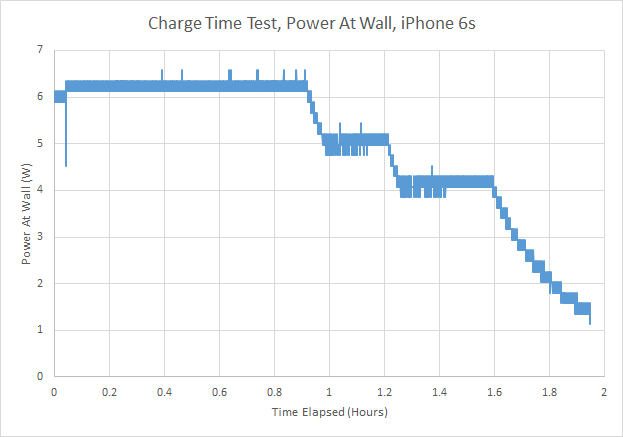
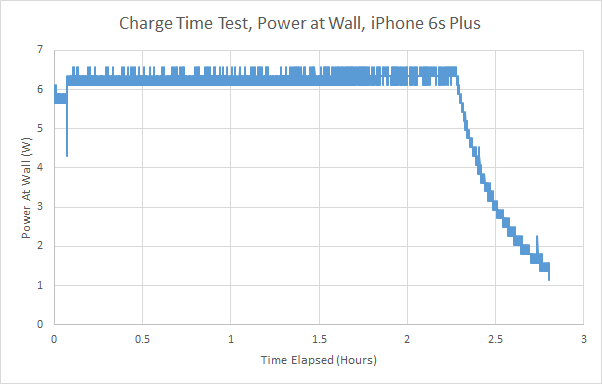








531 Comments
View All Comments
nerd1 - Saturday, November 7, 2015 - link
720p screen in 2015, worse battery life, no sd slot, no wiress charging, terrible camera and still THE BEST phone huh?It has best performing processor, no one argues that, but I still wont touch it with a stick.
JaytB1 - Sunday, November 8, 2015 - link
I use iPhone mainly because of the better security/privacy, no carrier/manufacturer delay/total dismissal of security/OS updates, earlier/exclusive/better releases of triple A games/apps and uncluttered interface. I agree with the gold award, the iPhone 6s (plus) is the first phone in a while that made me see that there are still possibilities to innovate in the smartphone space.I've seen Android users avidly defending their high PPI's, megapixels, core counts. Oh, but it's customizable and I can put a ton of widgets on my homescreens. There's only a small minority of tech obsessed people who care (proof is in the huge low/medium end market share, indicating the amount who don't care for specs but just want a working phone). For me, all I want is to launch an app, not stare at my home screen. In the past, Android users where more often than not boasting about benchmarks and how their hardware was superior. Now that the tables are turned, hardware all of a sudden doesn't matter as much anymore or the tests must be rigged by a biased Anandtech (who has nothing to gain and everything to loose if they were posting nonsense).
I've seen Samsung and other manufactures add so many gimmicks to their phones, many of which are plain impractical (try doing 'airview' while jogging and you'll get the picture).
I admit that fast charging would be nice but, for me, completely unnecessary (it's not like an iPhone charges slow in the first place).
Then there's wireless charging, you do realize that you still have to plug in the charge pad with a cable right? So the only difference is that you don't need to plug that cable into your phone, but you'll need more power to fill your device up as compared to using a cable (more waste power) and a permanent spot for your charging pad. Again, for me I don't really see the appeal for that either.
We could also talk about PPI but to keep it brief, I'd rather have a device perform well with individual pixels I can't distinguish, than a screen that would impact performance with pixels I still can't see... But more of them.
I could go on about how a blind photo evaluation test on a respected Android site had Android users voting the iPhone 6s as having the best overall picture quality, but now that the iPhone scored a tiny bit lower than some Android phones in one test, it suddenly has a 'far inferior' camera. Then there's the RAM, curved screens and so many other things I could mention, but my point is that I think Android users can't recognize a genuine game-changing feature-list because they're so used to getting bombarded by tons of arguably useless high spec lists and gimmicks that are marketed as 'the next big thing'.
It's almost as if Google took over the reality distortion field from Apple. Just wait a couple of years when all Android devices have 'Android sense' (or something) displays (3D touch), THEN it will be a game changing feature because they'll have 1000's of pressure levels they can sense as compared to the 'useless' iPhone's (hypothetical) 128 levels.
Don't get me wrong here, I'm not trying to bash Android or people who choose to use it, I just don't like those who post nonsense without anything to back it up just so they can sleep at night having convinced themselves that they bought the right phone. I've been a reader of this site for years and believe their test results to be correct, as they've always been. People who claim otherwise should come with facts or stop sprouting nonsense.
I, for one, agree with the review and think it's the phone with the best all round feature set on the market today. Is it perfect? Of course not, but it's a genuinely forward thinking and exceptional smartphone in a stale smartphone market, and that deserves that gold award in my book.
Thanks for the review!
Aritra Ghatak - Sunday, November 8, 2015 - link
As the reviewers pointed various aberration and distortions associated with using a brighter lens and that it is wise Apple went with the F 1/2.2 aperture lens. Could you please explain how Samsung manages with an F 1/1.9 aperture lens in Galaxy S6? Or for that matter the F 1/1.8 lens in LG G4 or Nokia Lumia 720/730?patamat - Sunday, November 8, 2015 - link
Well, we all know who Anand went to work for after writing few "balanced" reviews like this one.(apple ...)
Psymac - Monday, November 9, 2015 - link
Where is the phone function analysis of this iPhone?zimmybz - Tuesday, November 10, 2015 - link
I guess I'll try to build the bridge for the Droid guys here that are having a hard time.I haven't had an iPhone since the Galaxy S came out. Been a droid user since.
I recently got a 6S Plus. I sold a Note 5 and cancelled a pre-order for a Nexus 6P.
I will say it since nobody else will. The Note 5 has a great camera, S-Pen is cool, and enough RAM to keep multi-tasking running, but otherwise it's a shitty phone. The battery life and Touchwiz still leave a LOT to be desired. Build quality is great, but it suffers from what every other Droid phone suffers from - fractured, fragmented hardware eco-system and specs driven production. (Hang on)
If you need to know why you should cancel a 6P pre-order, look at the subreddit (Holy crap, lol.)
Anyways, in my first week with the 6S Plus, I hit 22% battery with 88 hours standy and 13 hours usage. That is completely insane.
Back to the Note 5 - look at the graphs on the review here. This phone absolutely DOMINATES the Note 5 across the board, a fact which I can confirm first hand.
I can also tell you that holding the phones side by side looking at the same picture taken on the Note 5, the displays are functionally indistinguishable from the other. (So much for all that resolution, I guess)
This is a large reason why the Note stutters against the 6S Plus. It's pushing a LOT of pixels that aren't really evident in day to day use, especially sitting next to the iPhone.
I guess I finally reached the point, I just want the best phone every year regardless of manufacturer or software.
Until Google makes it's own hardware in house and breaks free of QualComm, Apple is going to beat them every year going forward. I'm not 20 anymore, I don't care about a home screen widget. I want the battery not to drain from some stupid Google Play Services memory drain while the phone is sitting on my desk.
I don't want Samsung Services blowing up the battery either. And - NO - I should not have to root kit, Package Disable, Power Saver, Turn off Location, etc, etc, etc. I paid $1000 for a premium handset with lots of features.
Oddly enough, the iPhone can leave all that crap on and STILL get good battery life. The arguments for Android are shrinking right now. I'll never buy another Samsung phone again. I will miss the S-Pen, but Touchwiz is heinous, even in it's current iteration.
I would really love to see Google put up a fight in the premium handset market, but I don't think their hearts are in the hardware QUITE yet.
Anyways, happy 6S Plus user here, 4+ year droid convert at the moment. We'll see what next year brings.
zeeBomb - Wednesday, November 11, 2015 - link
Ss or bs (sorry I just had to)JTRCK - Friday, November 13, 2015 - link
I actually returned a 6S Plus for the Nexus 6P and the main reason was PRICE. They are as equally performant in day to day tasks, but the Nexus 6P had better multitasking performance for me due to the buttons and added power of a side launcher which is not possible on iPhone. I basically never have to go to the home screen again when using Google docs, searching the web, etc... I tried both out for about a week. The only feature I liked on the iPhone 6S Plus better was the cooler white colors of the LCD; other than that the Nexus 6P was better "for me" in every aspect. The phone "flies" in every sense of the word. No stutters, no lag, no unresponsiveness (typical of Samsungs). I have been an iPhone user since the 3GS. I also used the iPhone 6 Plus this year for 5 months.And I truthfully don't understand all this commotion over the new iPhone 6S Plus being the best phone ever released. Outside of "3D touch," there is not much difference in day to day performance or general use between both this year's model and last year's model. That is generally a great testament to iOS stability and performance. So much so that my old iPhone 4s opened apps faster, surfed faster, multitasked faster, etc, than my now defunct Note 4. Apple has been on top of their game for years, IDK why android fans have only now noticed. But iOS is truly very limited. You will sooner or later find out the gates keep you truly locked in.
But the main factor for me, again, was price. I do not in any way find the iPhone to be a better phone than the Nexus 6P. In fact, I find its system to be inferior in a multitude of ways. Is the iPhone Better than the Note 5 and all its clumsy and useless features? Yes. But the Nexus 6P is in a category all its own. Especially for $650. That is exactly what I paid for the 128GB model compared to the $1,170 I paid for the iPhone 6S Plus.
astroboy888 - Wednesday, November 11, 2015 - link
"FinFET transistors are necessary because as transistors get smaller their leakage (wasted power) goes up, and without FinFETs leakage would spiral out of control. In fact that’s exactly what happened on the 20nm nodes from Samsung and TSMC; both companies thought the leakage of planar transistors could be adequately controlled at 20nm, only for leakage to be a bigger problem than they expected"It is not they "discovered" 20nm leakage was high; therefore they switched to 16nm FinFet. This is an incorrect comment.
FinFet transistors structure had been on the road map and in development at TSMC for more than 10 years. TSMC's first finfet transistor was demonstrated in 2002 when the inventor Professor Chen-Ming Hu of UC Berkeley was working at TSMC as CTO. Therefore Finfet process had always been on the roadmap for 16nm process. The 20nm planar process had always been on the road map as a planar process. Every process node takes about 3-5 years to develop, so the customers (semiconductor chip designers) signs up 3-5 years before hand to co-work with TSMC to design a chip for that process. These were communicated ahead of time and contracts where signed.
In the late 1990s and early 2000s, the semiconductor industry was pushing for SOI (Silicon On Insulator such as GaAs "Gallium Arsenide), which completely eliminates leakage current. But the transistor performance turned out to be too unpredictable and too expensive to manufacture. Therefor the industry stuck with silicon, until FinFet structure was invented in 2000 and manufacturing process perfected some 10 years later.
gonsolo - Thursday, November 12, 2015 - link
If I may suggest something: I'd like to see app startup times as a benchmark from iPhone 5 onwards. This is something I'm doing a lot; waiting for apps to start.